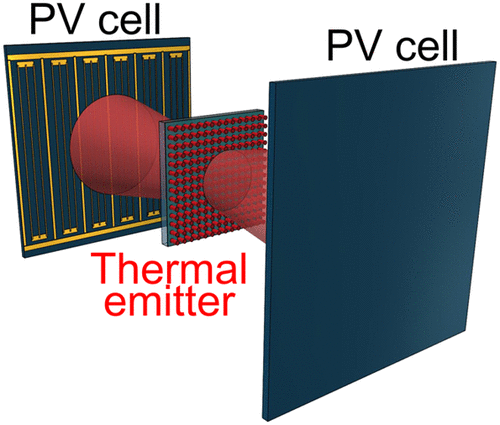当前位置:
X-MOL 学术
›
ACS Photonics
›
论文详情
Our official English website, www.x-mol.net, welcomes your feedback! (Note: you will need to create a separate account there.)
High-Efficiency Thermophotovoltaic System That Employs an Emitter Based on a Silicon Rod-Type Photonic Crystal
ACS Photonics ( IF 7 ) Pub Date : 2019-12-12 , DOI: 10.1021/acsphotonics.9b00984 Masahiro Suemitsu 1, 2 , Takashi Asano 1 , Takuya Inoue 1 , Susumu Noda 1
ACS Photonics ( IF 7 ) Pub Date : 2019-12-12 , DOI: 10.1021/acsphotonics.9b00984 Masahiro Suemitsu 1, 2 , Takashi Asano 1 , Takuya Inoue 1 , Susumu Noda 1
Affiliation

|
Thermophotovoltaic systems in principle enable utilization of heat that is usually regarded as wasted energy. However, the wavelength selectivity of the thermal emitter required for high efficiencies is difficult to control with conventional designs. Here, we design a thermophotovoltaic system, comprising silicon rods as thermal emitter with a relatively narrow emission spectrum and photovoltaic cells with a band gap corresponding to 1.76 μm, and verify efficient power generation. By accurately measuring the heat flux that enters the emitter, the emitter temperature, and the electrical output power of the photovoltaic cells, we find that the actual system efficiency (ratio of output power to ingoing heat flux) is 11.2% at an emitter temperature of 1338 K and the output power density footprint is 0.368 W/cm2. The obtained efficiency is relatively high, i.e., 1.65 times that of the previously reported record value (6.8%). Further efficiency improvements may lead to development of distributed energy supplies using combustion heat.
中文翻译:

采用基于硅棒型光子晶体的发射极的高效热光电系统
原则上,热电光伏系统可以利用通常被认为是浪费的能源的热量。然而,用常规设计难以控制高效所需的热发射器的波长选择性。在这里,我们设计了一个热光电系统,该系统包括硅棒作为具有相对窄的发射光谱的热发射器和带隙对应于1.76μm的光伏电池,并验证了有效的发电。通过精确测量进入发射器的热通量,发射器温度和光伏电池的电输出功率,我们发现,当发射器温度为时,实际系统效率(输出功率与传入热通量之比)为11.2%。 1338 K,输出功率密度足迹为0.368 W / cm 2。获得的效率相对较高,即是以前报告的记录值(6.8%)的1.65倍。进一步的效率提高可能导致使用燃烧热的分布式能源供应的发展。
更新日期:2019-12-13
中文翻译:

采用基于硅棒型光子晶体的发射极的高效热光电系统
原则上,热电光伏系统可以利用通常被认为是浪费的能源的热量。然而,用常规设计难以控制高效所需的热发射器的波长选择性。在这里,我们设计了一个热光电系统,该系统包括硅棒作为具有相对窄的发射光谱的热发射器和带隙对应于1.76μm的光伏电池,并验证了有效的发电。通过精确测量进入发射器的热通量,发射器温度和光伏电池的电输出功率,我们发现,当发射器温度为时,实际系统效率(输出功率与传入热通量之比)为11.2%。 1338 K,输出功率密度足迹为0.368 W / cm 2。获得的效率相对较高,即是以前报告的记录值(6.8%)的1.65倍。进一步的效率提高可能导致使用燃烧热的分布式能源供应的发展。



























 京公网安备 11010802027423号
京公网安备 11010802027423号